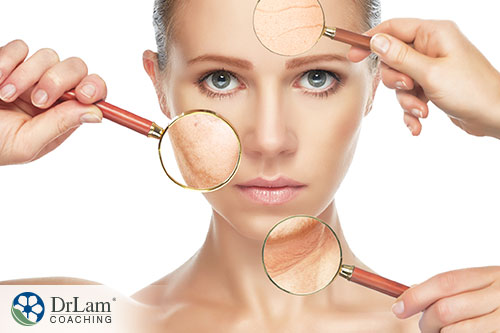 The relationship between your gut, skin and weight is an important one. Each one reflects the health of the other two. And each one reflects your overall health as well. Two of these components give you a visual clue as to what is going on inside you: skin and weight. Your gut, on the other hand, is the link between the other two. It affects both your skin and weight, while your skin doesn't affect your weight.
The relationship between your gut, skin and weight is an important one. Each one reflects the health of the other two. And each one reflects your overall health as well. Two of these components give you a visual clue as to what is going on inside you: skin and weight. Your gut, on the other hand, is the link between the other two. It affects both your skin and weight, while your skin doesn't affect your weight.
In this article, we will cover how your gut, skin and weight are related, and how they affect your health. We’ll also talk about how they tie into your NeuroEndoMetabolic (NEM) Stress Response, which is how your body handles stress. The Inflammation circuit of your NEM is the aspect most involved when it comes to your gut, skin and weight.
Your NEM is your body’s global response to stress. It is composed of six circuits of organs and systems that work together to fight stress. Your NEM’s other six circuits – the Hormone, the Bioenergetics, the Cardionomic, the Neuroaffect, and the Detoxification circuits – are also involved in the health of your gut, skin and weight. Just not as much as the Inflammation circuit.
Your adrenal glands are part of the Hormone circuit. And they are your NEM’s first line of defense against stress. They produce your body’s most important stress-fighter, cortisol. But they can dysregulate if faced with chronic stress.
Initially, they produce higher levels of cortisol in order to meet the growing demand. That marks the initial phases of Adrenal Fatigue Syndrome (AFS). But once they are exhausted and their cortisol output drops, the body moves into the more advanced stages of AFS.
Symptoms of AFS include fatigue, weight gain, insomnia, brain fog, anxiety, mild depression, PMS, infertility, low libido, estrogen dominance, lowered immunity, heart palpitations, hypoglycemia, salt and sugar cravings, gastrointestinal (GI) issues, food and drug sensitivities, an inability to handle stress, hair loss, and dry, itchy skin.
The reason AFS symptoms are so varied is because they are related to the different NEM circuits. When your adrenal glands dysregulate, the rest of your NEM has to compensate. Soon other aspects also often follow suit and dysregulate as well. There are many AFS symptoms related to your gut, skin and weight. The gut is a component of the Inflammation circuit, along with the microbiome and the immune system.
Frequently adrenal fatigue sufferers have a leaky gut. The causes are many, including:
Any of these can lead to dysbiosis, which is the imbalance of your gut microbiome. When that happens, the tight junctions in your gut’s lining loosen up. They then allow substances into your bloodstream that shouldn’t be there. As soon as your immune system notices this, it launches an attack and creates inflammation in your gut.
If this cycle repeats over and over again, the inflammation becomes chronic. Chronic inflammation can travel from the gut to the rest of your body, causing problems there. For example, it can travel to your joints, causing joint pain. It can also travel to your skin, causing skin issues.
You’ve probably already noticed that your skin’s condition heavily relies on your diet and digestive health. You have a “cheat meal” and the next day your skin breaks out or looks dull. But you may also have more serious skin conditions, such as acne, vitiligo, rosacea, psoriasis, scleroderma, and atopic dermatitis. And although many factors can influence your skin, such as your hormones, sleep, and water intake, your gut is still king when it comes to skin.
 Your skin is your largest organ. Its interface is over 320 square feet. And every part of it contains over 2.5 million bacteria. That’s the skin’s microbiome. And just like your gut, your skin microbiome has a huge influence on its health. It helps it perform its functions. Including being a protective barrier, collecting sensory information, and regulating temperature.
Your skin is your largest organ. Its interface is over 320 square feet. And every part of it contains over 2.5 million bacteria. That’s the skin’s microbiome. And just like your gut, your skin microbiome has a huge influence on its health. It helps it perform its functions. Including being a protective barrier, collecting sensory information, and regulating temperature.
Just like your gut microbiome, the strength of your skin microbiome comes from its diversity. Sadly, if you have skin issues and you go to your regular dermatologist, you may be given an antibiotic or an aggressive topical treatment. And although that might bring temporary relief, it ultimately weakens the diversity of the microbiome. It basically causes skin dysbiosis, which then leads to worse issues down the line.
So, one way to avoid this entire chain of events is to treat skin problems from the inside out, starting with inflammation in your gut. And the way to do that is to address the root causes of the inflammation.
This means eating a healthy diet, avoiding foods or substances that cause dysbiosis, and managing stress. To name a few. Following an individualized adrenal fatigue recovery plan will include all of these and more. The adrenal fatigue diet is the cornerstone of adrenal fatigue recovery. It is an anti-inflammatory diet that contains enough variety to help your gut and skin microbiomes regain their diversity.
Repopulating your microbiome with good bacteria and increasing their diversity is one of the keys to getting your gut, skin and weight back to a healthy state. And, contrary to popular belief, most probiotics supplements are not actually good at this, as they only promote one or two strains instead of overall diversity in your microbiome.
One of the most frustrating symptoms of AFS is how easily you can gain weight and how difficult it becomes to lose it. It’s not only a matter of lacking enough energy to be physically active. There are many factors involved that make weight an issue.
For example, cholesterol is a precursor to cortisol. Because it is stored in fat tissue, the body wants to keep these stores available when you have AFS to make more cortisol. That way, it can pull from these reserves to make extra cortisol.
Not only that, but your body also redistributes this fat to make it more central. That’s why you might notice your fat concentrates around your belly. With AFS, your entire body goes into energy conservation mode. And fat burning is the opposite of that.
As abdominal fat increases, it brings with it its own set of problems. It begins to create hypothyroidism and insulin resistance. And the more this goes on, the closer you will inch towards metabolic syndrome.
Metabolic syndrome’s symptoms are pretty close to AFS symptoms. They include things like sluggishness after eating, brain fog, fatigue, high cholesterol levels, high blood pressure levels, faster aging, and weight gain. If you don’t address this process, you can end up with heart disease, hypertension, type 2 diabetes, lipid problems, dementia, Alzheimer’s disease, polycystic ovarian syndrome, and cancer.
Sluggishness after eating can also be a sign of endotoxemia. This is especially the case if this sluggishness goes on three to four hours after a meal. Metabolic endotoxemia is basically an immune response to circulating endotoxins. Endotoxins are toxins produced by your body, and the most common type is lipopolysaccharide (LPS).
LPS circulates in lower-levels in healthy people, but those levels can increase with the type of diet you eat. Certain types of fat can increase the risk of metabolic endotoxemia, especially in people with existing medical conditions, like diabetes. Coconut oil, for example, can be very healthy for some, but for others, it can create endotoxemia. Olive oil is neutral. Fish oil can actually alleviate it.
Metabolic endotoxemia, and specifically that caused by LPS, can increase your risk of developing chronic conditions, such as:
 Anorexia nervosa
Anorexia nervosaEndotoxemia can be tested for by checking the serum concentration of LPS (or another endotoxin) five hours after a meal. Because it also increases certain inflammatory markers, those can be checked also. These include insulin levels, interferon-gamma, interleukin-6, interleukin-1-beta, and triglyceride levels.
What happens when high levels of LPS circulate through your system is that the LPS binds with certain complexes. These bindings trigger a cascade of immune responses that eventually lead to the release of pro-inflammatory cytokines.
These cytokines are why metabolic endotoxemia is another huge cause of inflammation, and it affects the entire body, including the blood-brain barrier. It’s also why it is linked to skin conditions including psoriasis, acne, vitiligo, rosacea, atopic dermatitis, and scleroderma.
With the skin, what usually happens is that the gut dumps the endotoxins into the liver, and the liver gets overloaded during the first two phases of elimination. This creates congestion. The slowed clearing increases toxicity levels that then manifests as skin issues.
Thankfully, because the gut, skin and weight are interconnected, they can be addressed with the same recovery approach. It begins with restoring your gut’s microbiome and digestive health.
First, you need to eliminate the issues that are causing the dysbiosis and leaks in the first place. That means eliminating possible allergenic foods from your diet. It also means you need to stop using topical products that can affect your skin microbiome. Your gut, skin and weight depend heavily on the diversity of your different microbiomes.
Then, you can start to rebuild the diversity of your microbiome by eating a variety of plant-based foods and adding a special kind of probiotic supplement. Most probiotics are not that useful because they only reinforce one or two strands of gram-positive bacteria. Those are usually Lactobacillus and Bifidobacterium lactis. Although these are helpful for your immune system, they don’t contribute to the diversity of your microbiome.
But using spores instead, such as Bacillus subtilis, can actually help tighten the junctions in your gut’s lining. Also, you can eat foods that help seal these leaks and feed the good bacteria. These include bone broth, kimchi, sauerkraut, kefir, yogurt, and other fermented foods.
Prebiotics, which are a type of dietary fiber, can help feed the good bacteria in your gut. They include things like chicory root, garlic, onions, asparagus, Jerusalem artichokes, and bananas. And, finally, certain amino acids and immunoglobulins can help rebuild your intestinal mucosa.
Although all of the above recommendations are very helpful steps to take in order to heal gut, skin and weight issues, there are certain precautions you need to take. This is especially the case if you have more advanced AFS.
First of all, changing your diet radically can actually add too much pressure on your adrenals. It might even induce a detox, and when your detox system is already congested, it can worsen your symptoms. Secondly, never take supplements without proper guidance if you have AFS. You may experience a paradoxical reaction or even an adrenal crash. And, lastly, recovery from gut, skin and weight issues should be individualized, as each person’s microbiome is different.
Your gut, skin and weight are all connected. And they are all affected by the health of your microbiome. The more diverse your microbiome is, the more resilient it is. Increasing its diversity, and rebalancing any kind of dysbiosis, is the key to healing gut, skin and weight issues.
 It is also very important to address the inflammation that is bound to be accompanying these issues. And the best way to do that is to eliminate the causes of inflammation, such as inflammatory foods and medications.
It is also very important to address the inflammation that is bound to be accompanying these issues. And the best way to do that is to eliminate the causes of inflammation, such as inflammatory foods and medications.
But making such drastic changes can add pressure to your adrenals, and the recovery process is complicated. That’s why you need the guidance of an experienced health professional.
If you have questions about any gut, skin and weight issues you may have, you can contact the Dr. Lam Coaching team. We can offer you a free** no-obligation phone consultation at +1 (626) 571-1234 where we will privately discuss your symptoms and what your options are. You can also send us a question through our Ask The Doctor system by clicking here.
Your gut skin and weight are connected through your microbiome, the ecosystem of flora in your body. And the way to ensure a strong microbiome is by keeping it diverse. To do that, you may need to make a few changes in your diet and lifestyle, but it could have huge benefits for your body.
